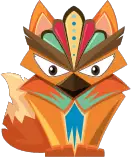Categories :
Random animals

Hi, It's me Gerenimot!
Generate a word.
Pictionary animals
Animals, a category for young and old. Our list contains all the animals on planet earth, from the best known to the most unsuspected. Mammals are heavily represented in easy mode for kids. In normal mode, reptiles appear to play with adults. Test the difficult mode to play with all the known animals, a real challenge!
How are animals classified?
When studying animal classification, it is important to know and understand the basic structure of an animal. Head, tail, body and limbs. The classification of animals is based on the characteristics that are present in a particular animal. These characteristics are divided into two groups. The first group is that of the external characteristics and the second that of the internal characteristics. External features are those that are present on an animal's body, and internal features are those that are present inside an animal's body. Classification is very important because it tells what animals look like. It shows the basic body structure and characteristics of each type of animal. It provides information on the structure of animals and their different characteristics. The classification of animals is based on the basic structure of animals. Classification is done based on the characteristics that are present in an animal. The different types of animals are categorized into different groups, and each group has a name. Groups are known as classes. The classification of animals is based on the number of characteristics present in an animal. If an animal has fewer characteristics than the others, it is considered to be in the lower class, and if the number of characteristics is higher than the others, it is considered to be in the higher class. The classification of animals is based on the external characteristics present on an animal. The characteristics are divided into two parts. The first group consists of the external characteristics and the second group consists of the internal characteristics. External features are those that are present on an animal's body, and internal features are those that are present inside an animal's body.
How are the external characteristics of an animal classified?
The external characteristics of an animal are classified into two parts. Each part is then divided into several groups. The first group is that of the head and the second that of the body. The external features, which are present in the head and the body, are categorized into several parts. The skull is the part of the body that is present in the head. The skull is divided into several parts. The skull is divided into three parts. The upper part of the skull is called the cranium, the middle part is called the face, and the lower part is called the mandible. The internal features of the skull are the eye, nose, and ear. The skull is the part of the body that sits inside the head. The skull is divided into several parts. The skull is divided into three parts. The upper part of the skull is called the cranium, the middle part is called the face, and the lower part is called the mandible. The internal features of the skull are the eye, nose, and ear. The mouth is the part of the body that is present in the head. The mouth is also divided into several parts. The internal features of the mouth are the tongue, gums and teeth.
Random Word Generator
The Random Word Generator is a tool to help you create a list of random words. The tool generates random words for you to use in your writing or other creative projects.
Random in Computers
Computers can generate truly random numbers if given a source of entropy. This is used in cryptography where truly random numbers are needed, for example for creating encryption keys. Computers can also be used to simulate random events. By generating a series of random numbers from a stochastic process, like a Poisson process or a Markov process, a simulation of the process itself can be obtained. This is used in computer animation for the generation of natural looking phenomena, for example the way water flows in a stream. Random number generation is also used in statistical sampling to generate a representative sample from a population. If a sequence of numbers is naively generated from a true random number generator, the numbers may appear to have a pattern. The period of this pattern is the length of the seed number used. Once the whole seed number has been used, the sequence repeats. Since computers can only store and manipulate numbers as a discrete set of values, in practice all computer-generated random numbers are random. That is, each number is associated with a specific algorithm and stream of data, and the characteristics of that data affect the numbers generated. In other words, the sequence of numbers is determined by the program, which is a deterministic process. The problem is that if the algorithm is not truly random, it is possible, by examining the patterns in the sequence of numbers, to predict future values in the sequence. This is a form of statistical attack. This can be countered by changing the seed number periodically. With each new seed, a different sequence is started, which as far as is known, has an unpredictable pattern. This is exactly what is done for the sequences in many types of random number generators, including those used in computer graphics and games. In these applications, the sequence of numbers is usually displayed. Anyone who knows the algorithm can then "re-seed" the generator, with the seed number found from the sequence, and thus generate the same sequence of numbers. In computer graphics, this is not considered a problem, as what is being displayed is the pattern, not the numbers. In cryptography and computer security, however, it is a problem, since an attacker can use such a sequence of numbers to predict future values. random numbers are random enough for most practical purposes. For example, they may be used in simulations involving games of chance, like poker or blackjack. The random numbers are used to determine the outcome.

 Categories
Categories